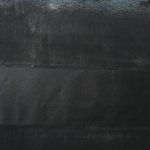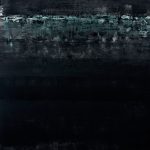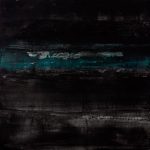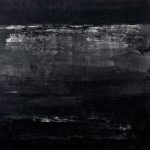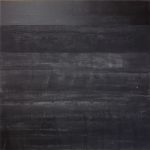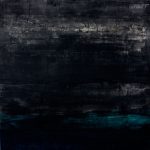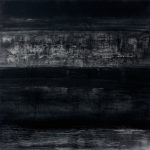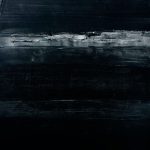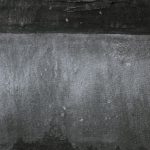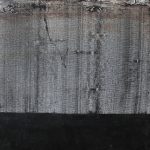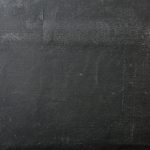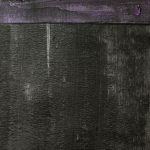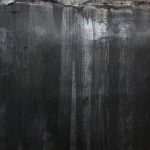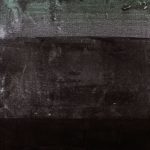Serie negra
(Facturas de guerra)
Formalmente, esta serie de pinturas se centra en explorar la tensión entre la luz y la oscuridad, así como entre la opacidad y la transparencia, y la estructura y la libertad en la composición.
La técnica empleada consiste en superponer capas de pintura, aplicar pinceladas imperceptibles y utilizar diferentes densidades y tonalidades de negro para generar texturas, transparencias y zonas opacas y brillantes, dejando ver la trama de la tela a través de sucesivas capas transparentes. Por lo tanto, algunas áreas creadas son ásperas y otras suaves, con una apariencia de acumulación de polvo.
Las áreas brillantes y los contrastes sutiles en estas obras se complementan entre sí y crean una experiencia visual intensa. La trama de la tela sobre la que han sido trabajadas queda patente en las zonas de textura dura y suave, aportando un aspecto táctil y sensorial a estas pinturas.
Las bandas horizontales son un elemento importante en la composición de la obra, creando contraste y una sensación de movimiento y dirección.
El uso de acrílico y témpera acentúa una sensación de profundidad y dimensión en el trabajo.
Marcela Jardón
Black Series
(War Bills)
Formally, this series of paintings focuses on exploring the tension between light and dark, as well as between opacity and transparency, and structure and freedom in composition.
The technique used consists of superimposing layers of paint, applying imperceptible brushstrokes and using different densities and shades of black to generate textures, transparencies and opaque and shiny areas, revealing the texture of the fabric through successive transparent layers. Therefore, some areas created are rough and some are smooth, with an appearance of dust accumulation.
Bright areas and subtle contrasts in these works complement each other and create an intense visual experience. The texture of the fabric on which they have been worked is evident in the areas of marked and soft texture, providing a tactile and sensory aspect to these paintings.
The horizontal bands are an important element in the composition of the work, creating contrast and a sense of movement and direction.
The use of acrylic and tempera accentuates a sense of depth and dimension in the work.
Marcela Jardón
La pintura de Marcela Jardón: la profundidad de lo subjetivo
“(…) Como se dijo antes, cuando Jardón aborda una obra, no le importa demasiado el soporte elegido, ni siquiera la técnica o la apariencia definitiva de la pieza, pues trabaja desde la pura conceptualización y de ahí nace una selección muy concreta de los medios necesarios para encarnar su propuesta; lo que palpita en su psique. Y cuida todos los detalles, aparte de ir experimentando a lo largo de los años. Para nuestra protagonista, la labor de idear aquello que quiere transmitir mediante una obra de arte es complicada y rigurosa —en este aspecto, entronca con la severidad de Reinhardt—. Lo suyo no se trata de hacer emerger una emoción intensa y plasmarla en la obra, como en un vaciado espontáneo del yo. De ahí que esté tan alejada de lo gestual, de lo veloz, desde la óptica plástica, prefiriendo practicar una pintura meditada que externalice su subjetividad en lugar de ser una explosión de pulsiones creativas.
Al elaborar las pinturas negras, da una particular importancia a la textura aterciopelada; los rasgos hápticos se incrementan. Se percibe un refinamiento para alcanzar la texturización de las piezas, pero a la par, lo táctil aquí puede generar una cierta incomodidad visual. No se transmite una sensación de llanura, sino todo lo contrario; eso que Reinhardt tanto detestó. El público hunde sus ojos en un mar sombrío y no encuentra un hipotético horizonte bien definido. Pero de nuevo, hay una coherencia entre idea y objeto: lo que se muestra es el concepto de tristeza, de guerra y de muerte. Es un punto de inflexión en la carrera de Jardón. El color es simbólico, pero también negativo porque respeta nuestra tradición occidental. Y alude a un problema que, sin embargo, afecta a todo el globo: el asunto bélico en Ucrania; la invasión de Ucrania por parte de Rusia. ‘’No tiempo. […] Una obra de arte está siempre presente»’’. En cierto modo, la cita del autor es auténtica aquí, pues aunque se evoca una época determinada, un hecho del presente, también es cierto que los conflictos bélicos tienen un punto de intemporalidad porque no cesan jamás.
Existen diversas circunstancias respecto al porqué de cada guerra, pero la cuestión es que se sigue manteniendo la idea generalizada de que la lucha armada es lícita para conseguir un objetivo. No importa que sea el año 1337 o el 2023; los intereses no se modifican demasiado —sumisión de un pueblo a otro por su cultura, explotación de las riquezas materiales ajenas, etc. —. En este aspecto, Jardón tiene antecedentes tan evidentes como Francisco de Goya con las homónimas pinturas negras facturadas en las paredes de la Quinta del Sordo que marcan el fin de su carrera, aunque también de su vida. Unas pinturas que en muchos casos se consideran vinculadas a la congoja, no solo por el tema, sino sobre todo por el tratamiento lóbrego de las representaciones.
Para Jardón, no es relevante a qué distancia se encuentre la guerra; es un hecho que afecta a todo el planeta y por el que debemos condolernos. La cromática y las texturas manifiestan su dolido y empático interior en colores, relieves y depresiones. Aquí, empieza a emplear témpera para lograr la textura de terciopelo, conseguir un aspecto mitigado y también con un propósito ecologista.
Efectivamente, la pintura orgánica al temple que usa nuestra artista pretende no solo enriquecer su carrera artística en cuanto a técnicas utilizadas, sino también minimizar el empleo del acrílico. La pintura acrílica está basada en polímeros sintéticos, es decir, tiene un origen artificial, industrial. Asimismo, a la artista le recuerda cómo vivimos en una época de masividad de los plásticos, que normalmente son derivados del petróleo y a su vez este alude al agotamiento de los recursos naturales y al calentamiento global.(…)”
Fragmento del artículo
La pintura de Marcela Jardón: la profundidad de lo subjetivo
Por Andrea García Casal. 2023 Publicado en PAC
La pintura de Marcela Jardón: la profundidad de lo subjetivo
La pintura de Marcela Jardón_ la profundidad de lo subjetivo –
The painting of Marcela Jardón: The Depth of Subjectivity.
“(…) As mentioned earlier, when Jardón starts on a piece, she is not particularly invested in the type of support or technique she’s using or how it looks in the end. She begins with sheer conceptualization, and from there makes concrete choices of the media she needs to bring her idea —as it pulses through her mind— to fruition. She is particular with the details, and has continued to experiment over the years. Our featured artist’s task of thinking out what she wants to transmit through her art is complicated and rigorous —in this sense, she ascribes to Reinhardt’s severity. She is not concerned with teasing out an intense emotion and pasting it onto the piece, as if it were some spontaneous emptying of the id. In this way she distances herself from gesture and speed —from a visual arts point of view— preferring to think through her painting and externalize her subjectivity rather than blast out explosions of creativity.
When she works on her black paintings, she takes care to give them a velvety texture—to increase the haptic effect. Refinement is evident in how the paintings are texturized but, at the same time, this tactility can generate a certain visual unease. Visually her paintings feel like velvet. They give off not a sense of smoothness but the exact opposite: what Reinhardt so detested. A viewer’s gaze sinks into a murky sea, incapable of fixing onto a hypothetical, well-defined horizon. Yet, again, there is coherence between idea and object: what is on display is the concept of sadness, war, death. This is a point of inflection in Jardón’s career. Color is symbolic, but also negative in that it respects our western tradition. Even so, it also alludes to a problem affecting the entire world: the armed conflict in Ukraine; Russia’s invasion of Ukraine. “No time. […] ‘A work of art is always present.’” In a way, this quote rings true here. Although a particular era —a current event— is evoked, it is also true that armed conflicts have a degree of timelessness because they never end.
There are always several circumstances regarding the cause of every war, but the general idea remains that armed 1337 or 2023, there seems to be no great variation in the stakes involved: one nation subjugated by another based on culture, exploitation of other cultures’ material wealth, etc. In this sense, Jardón has predecessors as unmistakable as Francisco de Goya and the Black Paintings that were torn from the walls of his Quinta del Sordo home, marking not only the end of his career, but the end of his life as well. Paintings which in many cases are thought to be linked to heartache, not just because of the subject matter, but especially due to the grimness of the images depicted.
Jardón doesn’t find it relevant to consider how far away a war is; it is an event that affects the entire planet and for which we need to offer condolences even to ourselves. Her chromatics and textures showcase her inner empathy and pain through color and a layered effect. Here she begins to use tempera to achieve a velvety texture, a look that is muted while suggesting an ecological objective.
Indeed, our artist uses organic tempera paint not only to enrich her artistic career in terms of technique, but also to minimize the use of acrylics. Acrylic paint uses synthetic polymers, and so has an artificial, industrial origin. It is also a constant reminder to the artist that we live in an era of massive use of plastics, which usually come from petroleum products, therefore also alluding to global warming and the depletion of our natural resources.(…)”
Fragment of the article
The painting of Marcela Jardón: The Depth of Subjectivity.
By Andrea García Casal. 2023 Published in PAC
https://www.plataformadeartecontemporaneo.com/pac/la-pintura-de-marcela-jardon-la-profundidad-de-lo-subjetivo/
“The Depth of Subjectivity” PAC Casal EN_kymm
Visitas: 4
